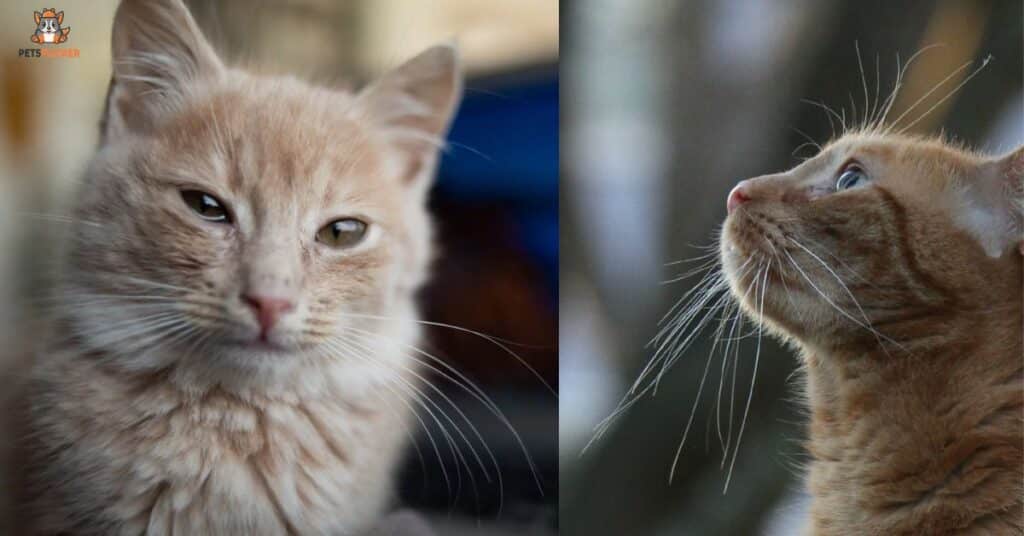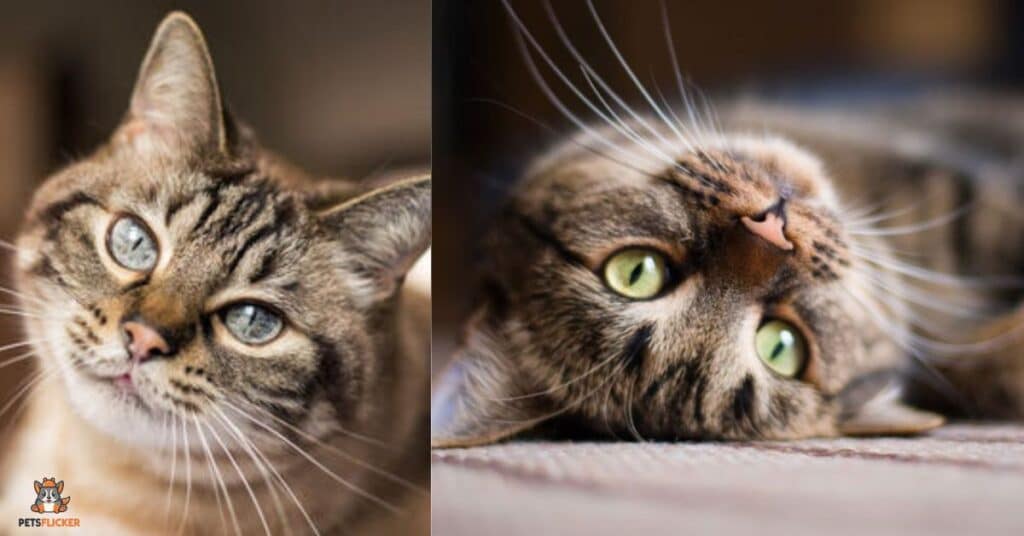Cats do not have eyebrows like humans have. Instead, they have whiskers located above their eyes that serve similar purposes. These whiskers help cats sense their surroundings and protect their eyes from potential harm.
Cats lack visible eyebrows, their whiskers above the eyes act as sensitive detectors, aiding in communication and navigation. These whiskers play a crucial role in helping cats gauge distances and assess their environment’s safety.
In essence, Cats may not possess eyebrows like humans; their whiskers fulfill similar functions, making them essential sensory tools for these agile and curious creatures.
What Are Whiskers?
Whiskers, also referred to as vibrissae, are specialized hairs located on a cat’s face and body. They are no longer everyday hairs however are deeply rooted in nerve cells and blood vessels, making them tremendously touchy tactile organs.

Those whiskers serve diverse purposes for cats. They help them navigate their surroundings by sensing obstacles and changes of their surroundings. Whiskers also play a position in verbal exchange, conveying the cat’s mood and intentions via their positioning and movement.
Whiskers are essential equipment for cats, helping in balance, spatial recognition, communication, and safety. Their sensitivity and flexibility cause them to essential components of a cat’s sensory system.
The Function Of Whiskers
Whiskers serve critical capabilities for cats. They help cats navigate their surroundings by sensing changes in air currents, alerting them to obstacles or prey nearby. Whiskers play a function in conversation, conveying a cat’s emotions and intentions through their function and movement.
Whiskers are a useful resource in shielding a cat’s eyes and face from ability harm. They’re distinctly sensitive tactile organs that may come across even small items near the eyes; supporting cats keep away from harm and hold their safety whilst exploring their environment.
Read This Article: Can Cats Eat Ginger? Understanding The Risks & Benefits
Eyebrow Whiskers in Cats – Fact or Fiction?
Eyebrow whiskers in cats are indeed a fact, not fiction. They may not be as prominent as the whiskers above the upper lip, cats do have whiskers around their eyebrows. These whiskers, also known as supraorbital vibrissae, serve similar functions to other whiskers on a cat’s face.
The eyebrow whiskers help cats in various ways. They contribute to their sensory perception, aiding in navigation, balance, and detecting potential hazards near the eyes. These whiskers also play a role in communication, as their position and movement can convey a cat’s mood and level of alertness.
In essence, eyebrow whiskers may be less noticeable compared to other whiskers, they are an essential part of a cat’s sensory system, enhancing their abilities and contributing to their overall well-being.
Top 5 Interesting Uses of Whiskers for Cats
Whiskers, also known as vibrissae, play a pivotal role in a cat’s sensory perception and overall well-being. The functions of whiskers can be categorized into several key areas, showcasing their versatility and importance in a cat’s daily life.
1. Balance and Coordination
Whiskers serve as vital tools for maintaining balance and coordination. By providing feedback to the brain about the cat’s body position and surroundings, whiskers enable cats to navigate obstacles with precision and agility, contributing to their famed ability to land on their feet even from great heights.
2. Communication and Mood Indicators
Whiskers are also essential for communication and expressing mood. Cats use the positioning and movement of their whiskers to convey emotions such as curiosity, contentment, or alertness. Forward-facing and erect whiskers signal interest or excitement, while relaxed whiskers indicate a sense of comfort and relaxation.
3. Navigation and Environmental Awareness
In addition to balance, whiskers aid in navigation, particularly in low-light conditions. Cats rely on their whiskers to sense objects and potential threats in their environment, helping them navigate safely through dimly lit spaces and unfamiliar terrain.
4. Protection and Sensory Detection
Whiskers act as protective mechanisms, detecting hazards near the eyes and face. Their sensitivity allows cats to detect minute objects or changes in airflow, alerting them to potential dangers and preventing injuries or accidents.
5. Locating Food and Prey
Whiskers also play a crucial role in hunting and locating food. Cats use their whiskers to sense vibrations, helping them pinpoint prey or locate food and water sources, especially in darkness or when visibility is limited.
Whiskers are not just ordinary hairs but intricate sensory organs that contribute significantly to a cat’s abilities, behavior, and survival instincts. Understanding the multifaceted role of whiskers enhances our appreciation for these remarkable feline features.
Also Read This Article: Meet The Tabby Bengal Cat – Exotic Elegance Of A Hybrid Cat
Top 5 Facts About Cats’ Whiskers

1. Whiskers Can Grow Back
If a cat’s whiskers become damaged or fall out, they can grow back. Cats may also naturally shed whiskers as they age, with regrowth typically taking 1 to 2 months, depending on the cat’s age and health.
2. They Are Symmetrical
Most cats have an average of 24 whiskers, with 12 on each side of their face. While the patterning of whiskers may vary between individual cats, they are generally symmetrical in their arrangement.
3. Whiskers Aren’t Just on the Face
While the most prominent whiskers are on a cat’s face, they also have whiskers around their ears, jaw, and forelegs. These whiskers serve similar purposes to those on the face, aiding in sensory perception and navigation.
4. They Can Change Color
Unlike regular hairs that often lighten with age, a cat’s whiskers may darken with age, turning from light gray to darker shades or even black. This color change is a natural part of the aging process in cats.
5. You Should Never Cut Whiskers
It’s crucial never to trim or cut a cat’s whiskers. Whiskers are integral for a cat’s sensory perception, aiding in balance, communication, and protection. Cutting whiskers can disorient a cat and hinder its ability to navigate and interact with its environment effectively.
Frequently Asked Questions
What are the main functions of a cat’s whiskers?
Whiskers serve purposes such as balance, communication, navigation, protection, and locating food.
Do all cats have eyebrow whiskers?
Yes, all cats have eyebrow whiskers, although they may be less noticeable than other whiskers.
How many whiskers do most cats have?
Most cats have an average of 24 whiskers, with 12 on each side of their face.
Can whiskers grow back if they are damaged or fall out?
Yes, whiskers can grow back if they are damaged or lost, typically within 1 to 2 months.
What is the significance of whiskers in a cat’s balance and coordination?
Whiskers provide sensory feedback to the brain, aiding cats in maintaining balance and coordination.
Why is it important never to cut a cat’s whiskers?
Cutting whiskers can disorient a cat and hinder its ability to navigate and perceive its environment effectively.
How do whiskers change with age in cats?
Whiskers may darken with age, turning from light gray to darker shades or even black, as part of the natural aging process.
Conclusion
After exploring the various facets of whiskers and the presence of eyebrow whiskers in cats, it’s evident that cats indeed have eyebrow whiskers. These whiskers, though less conspicuous than others, are essential sensory organs contributing to a cat’s overall well-being. They aid in balance, communication, protection, and navigation, showcasing their significance in a cat’s daily life.
The fact that all cats have eyebrow whiskers highlights the uniformity in their anatomical features across different breeds. A cat is a Persian with long, luxurious whiskers or a Siamese with shorter ones, the presence of eyebrow whiskers remains consistent, emphasizing their functional importance rather than their appearance.
The truth about whiskers and eyebrow whiskers in cats reveals the intricate nature of these sensory organs. Understanding and appreciating the role of whiskers can deepen our connection with our feline companions, enriching our interactions and care for these fascinating creatures.

Elax is a seasoned writer with five years of experience specializing in articles focused on pets. His passion for animals and extensive knowledge shines through his engaging and informative writing style, captivating readers with insights into pet care and companionship. With a knack for crafting compelling content, Elax brings a wealth of expertise to the realm of pet-centric literature on your website.







